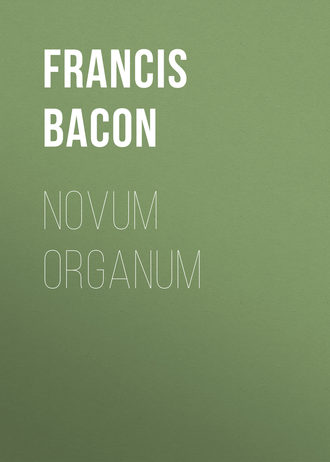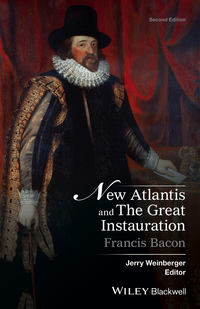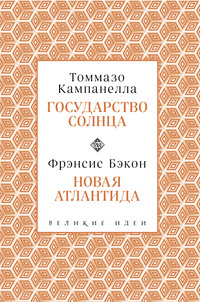 полная версия
полная версияNovum Organum
Hence an excellent rule is derived for the opening and dissolution of bodies; for (not to mention corrosive and strong waters, which force their way) if a body can be found which is more adapted, suited, and friendly to a given solid, than that with which it is by some necessity united, the given solid immediately opens and dissolves itself to receive the former, and excludes or removes the latter.153 Nor is the effect or power of this motion confined to contact, for the electric energy (of which Gilbert and others after him have told so many fables) is only the energy excited in a body by gentle friction, and which does not endure the air, but prefers some tangible substance if there be any at hand.
Let the seventh be that which we term the motion of greater congregation, by which bodies are borne toward masses of a similar nature, for instance, heavy bodies toward the earth, light to the sphere of heaven. The schools termed this natural motion, by a superficial consideration of it, because produced by no external visible agent, which made them consider it innate in the substances; or perhaps because it does not cease, which is little to be wondered at, since heaven and earth are always present, while the causes and sources of many other motions are sometimes absent and sometimes present. They therefore called this perpetual and proper, because it is never interrupted, but instantly takes place when the others are interrupted, and they called the others adscititious. The former, however, is in reality weak and slow, since it yields, and is inferior to the others as long as they act, unless the mass of the body be great; and although this motion have so filled men’s minds, as almost to have obscured all others, yet they know but little about it, and commit many errors in its estimate.
Let the eighth be that which we term the motion of lesser congregation, by which the homogeneous parts in any body separate themselves from the heterogeneous and unite together, and whole bodies of a similar substance coalesce and tend toward each other, and are sometimes congregated, attracted, and meet, from some distance; thus in milk the cream rises after a certain time, and in wine the dregs and tartar sink; which effects are not to be attributed to gravity and levity only, so as to account for the rising of some parts and the sinking of others, but much more to the desire of the homogeneous bodies to meet and unite. This motion differs from that of need in two points: 1st, because the latter is the stimulus of a malignant and contrary nature, while in this of which we treat (if there be no impediment or restraint), the parts are united by their affinity, although there be no foreign nature to create a struggle; 2dly, because the union is closer and more select. For in the other motion, bodies which have no great affinity unite, if they can but avoid the hostile body, while in this, substances which are connected by a decided kindred resemblance come together and are molded into one. It is a motion existing in all compound bodies, and would be readily seen in each, if it were not confined and checked by the other affections and necessities of bodies which disturb the union.
This motion is usually confined in the three following manners: by the torpor of the bodies; by the power of the predominating body; by external motion. With regard to the first, it is certain that there is more or less sluggishness in tangible bodies, and an abhorrence of locomotion; so that unless excited they prefer remaining contented with their actual state, to placing themselves in a better position. There are three means of breaking through this sluggishness – heat; the active power of a similar body; vivid and powerful motion. With regard to the first, heat is, on this account, defined as that which separates heterogeneous, and draws together homogeneous substances; a definition of the Peripatetics which is justly ridiculed by Gilbert, who says it is as if one were to define man to be that which sows wheat and plants vineyards; being only a definition deduced from effects, and those but partial. But it is still more to be blamed, because those effects, such as they are, are not a peculiar property of heat, but a mere accident (for cold, as we shall afterward show, does the same), arising from the desire of the homogeneous parts to unite; the heat then assists them in breaking through that sluggishness which before restrained their desire. With regard to the assistance derived from the power of a similar body, it is most conspicuous in the magnet when armed with steel, for it excites in the steel a power of adhering to steel, as a homogeneous substance, the power of the magnet breaking through the sluggishness of the steel. With regard to the assistance of motion, it is seen in wooden arrows or points, which penetrate more deeply into wood than if they were tipped with iron, from the similarity of the substance, the swiftness of the motion breaking through the sluggishness of the wood; of which two last experiments we have spoken above in the aphorism on clandestine instances.154
The confinement of the motion of lesser congregation, which arises from the power of the predominant body, is shown in the decomposition of blood and urine by cold. For as long as these substances are filled with the active spirit, which regulates and restrains each of their component parts, as the predominant ruler of the whole, the several different parts do not collect themselves separately on account of the check; but as soon as that spirit has evaporated, or has been choked by the cold, then the decomposed parts unite, according to their natural desire. Hence it happens, that all bodies which contain a sharp spirit (as salts and the like), last without decomposition, owing to the permanent and durable power of the predominating and imperious spirit.
The confinement of the motion of lesser congregation, which arises from external motion, is very evident in that agitation of bodies which preserves them from putrefaction. For all putrefaction depends on the congregation of the homogeneous parts, whence, by degrees, there ensues a corruption of the first form (as it is called), and the generation of another. For the decomposition of the original form, which is itself the union of the homogeneous parts, precedes the putrefaction, which prepares the way for the generation of another. This decomposition, if not interrupted, is simple; but if there be various obstacles, putrefactions ensue, which are the rudiments of a new generation. But if (to come to our present point) a frequent agitation be excited by external motion, the motion toward union (which is delicate and gentle, and requires to be free from all external influence) is disturbed, and ceases; which we perceive to be the case in innumerable instances. Thus, the daily agitation or flowing of water prevents putrefaction; winds prevent the air from being pestilent; corn turned about and shaken in granaries continues clean: in short, everything which is externally agitated will with difficulty rot internally.
We must not omit that union of the parts of bodies which is the principal cause of induration and desiccation. When the spirit or moisture, which has evaporated into spirit, has escaped from a porous body (such as wood, bone, parchment, and the like), the thicker parts are drawn together, and united with a greater effort, and induration or desiccation is the consequence; and this we attribute not so much to the motion of connection (in order to prevent a vacuum), as to this motion of friendship and union.
Union from a distance is rare, and yet is to be met with in more instances than are generally observed. We perceive it when one bubble dissolves another, when medicines attract humors from a similarity of substance, when one string moves another in unison with it on different instruments, and the like. We are of opinion that this motion is very prevalent also in animal spirits, but are quite ignorant of the fact. It is, however, conspicuous in the magnet, and magnetized iron. While speaking of the motions of the magnet, we must plainly distinguish them, for there are four distinct powers or effects of the magnet which should not be confounded, although the wonder and astonishment of mankind has classed them together. 1. The attraction of the magnet to the magnet, or of iron to the magnet, or of magnetized iron to iron. 2. Its polarity toward the north and south, and its variation. 3. Its penetration through gold, glass, stone, and all other substances. 4. The communication of power from the mineral to iron, and from iron to iron, without any communication of the substances. Here, however, we only speak of the first. There is also a singular motion of attraction between quicksilver and gold, so that the gold attracts quicksilver even when made use of in ointment; and those who work surrounded by the vapors of quicksilver, are wont to hold a piece of gold in their mouths, to collect the exhalations, which would otherwise attack their heads and bones, and this piece soon grows white.155 Let this suffice for the motion of lesser congregation.
Let the ninth be the magnetic motion, which, although of the nature of that last mentioned, yet, when operating at great distances, and on great masses, deserves a separate inquiry, especially if it neither begin in contact, as most motions of congregation do, nor end by bringing the substances into contact, as all do, but only raise them, and make them swell without any further effect. For if the moon raise the waters, or cause moist substances to swell, or if the starry sphere attract the planets toward their apogees, or the sun confine the planets Mercury and Venus to within a certain distance of his mass;156 these motions do not appear capable of being classed under either of those of congregation, but to be, as it were, intermediately and imperfectly congregative, and thus to form a distinct species.
Let the tenth motion be that of avoidance, or that which is opposed to the motion of lesser congregation, by which bodies, with a kind of antipathy, avoid and disperse, and separate themselves from, or refuse to unite themselves with others of a hostile nature. For although this may sometimes appear to be an accidental motion, necessarily attendant upon that of the lesser congregation, because the homogeneous parts cannot unite, unless the heterogeneous be first removed and excluded, yet it is still to be classed separately,157 and considered as a distinct species, because, in many cases, the desire of avoidance appears to be more marked than that of union.
It is very conspicuous in the excrements of animals, nor less, perhaps, in objects odious to particular senses, especially the smell and taste; for a fetid smell is rejected by the nose, so as to produce a sympathetic motion of expulsion at the mouth of the stomach; a bitter and rough taste is rejected by the palate or throat, so as to produce a sympathetic concussion and shivering of the head. This motion is visible also in other cases. Thus it is observed in some kinds of antiperistasis, as in the middle region of the air, the cold of which appears to be occasioned by the rejection of cold from the regions of the heavenly bodies; and also in the heat and combustion observed in subterranean spots, which appear to be owing to the rejection of heat from the centre of the earth. For heat and cold, when in small quantities, mutually destroy each other, while in larger quantities, like armies equally matched, they remove and eject each other in open conflict. It is said, also that cinnamon and other perfumes retain their odor longer when placed near privies and foul places, because they will not unite and mix with stinks. It is well known that quicksilver, which would otherwise reunite into a complete mass, is prevented from so doing by man’s spittle, pork lard, turpentine and the like, from the little affinity of its parts with those substances, so that when surrounded by them it draws itself back, and its avoidance of these intervening obstacles is greater than its desire of reuniting itself to its homogeneous parts; which is what they term the mortification of quicksilver. Again, the difference in weight of oil and water is not the only reason for their refusing to mix, but it is also owing to the little affinity of the two; for spirits of wine, which are lighter than oil, mix very well with water. A very remarkable instance of the motion in question is seen in nitre, and crude bodies of a like nature, which abhor flame, as may be observed in gunpowder, quicksilver and gold. The avoidance of one pole of the magnet by iron is not (as Gilbert has well observed), strictly speaking, an avoidance, but a conformity, or attraction to a more convenient situation.
Let the eleventh motion be that of assimilation, or self-multiplication, or simple generation, by which latter term we do not mean the simple generation of integral bodies, such as plants or animals, but of homogeneous bodies. By this motion homogeneous bodies convert those which are allied to them, or at least well disposed and prepared, into their own substance and nature. Thus flame multiplies itself over vapors and oily substances and generates fresh flame; the air over water and watery substances multiplies itself and generates fresh air; the vegetable and animal spirit, over the thin particles of a watery or oleaginous spirit contained in its food, multiplies itself and generates fresh spirit; the solid parts of plants and animals, as the leaf, flower, the flesh, bone and the like, each of them assimilate some part of the juices contained in their food, and generate a successive and daily substance. For let none rave with Paracelsus, who (blinded by his distillations) would have it, that nutrition takes place by mere separation, and that the eye, nose, brain and liver lie concealed in bread and meat, the root, leaf and flower, in the juice of the earth; asserting that just as the artist brings out a leaf, flower, eye, nose, hand, foot and the like, from a rude mass of stone or wood by the separation and rejection of what is superfluous; so the great artist within us brings out our several limbs and parts by separation and rejection. But to leave such trifling, it is most certain that all the parts of vegetables and animals, as well the homogeneous as organic, first of all attract those juices contained in their food, which are nearly common, or at least not very different, and then assimilate and convert them into their own nature. Nor does this assimilation, or simple generation, take place in animated bodies only, but the inanimate also participate in the same property (as we have observed of flame and air), and that languid spirit, which is contained in every tangible animated substance, is perpetually working upon the coarser parts, and converting them into spirit, which afterward is exhaled, whence ensues a diminution of weight, and a desiccation of which we have spoken elsewhere.158
Nor should we, in speaking of assimilation, neglect to mention the accretion which is usually distinguished from aliment, and which is observed when mud grows into a mass between stones, and is converted into a stony substance, and the scaly substance round the teeth is converted into one no less hard than the teeth themselves; for we are of opinion that there exists in all bodies a desire of assimilation, as well as of uniting with homogeneous masses. Each of these powers, however, is confined, although in different manners, and should be diligently investigated, because they are connected with the revival of old age. Lastly, it is worthy of observation, that in the nine preceding motions, bodies appear to aim at the mere preservation of their nature, while in this they attempt its propagation.
Let the twelfth motion be that of excitement, which appears to be a species of the last, and is sometimes mentioned by us under that name. It is, like that, a diffusive, communicative, transitive and multiplying motion; and they agree remarkably in their effect, although they differ in their mode of action, and in their subject matter. The former proceeds imperiously and with authority; it orders and compels the assimilated to be converted and changed into the assimilating body. The latter proceeds by art, insinuation and stealth, inviting and disposing the excited toward the nature of the exciting body. The former both multiplies and transforms bodies and substances; thus a greater quantity of flame, air, spirit and flesh is formed; but in the latter, the powers only are multiplied and changed, and heat, the magnetic power, and putrefaction, in the above instances, are increased. Heat does not diffuse itself when heating other bodies by any communication of the original heat, but only by exciting the parts of the heated body to that motion which is the form of heat, and of which we spoke in the first vintage of the nature of heat. Heat, therefore, is excited much less rapidly and readily in stone or metal than in air, on account of the inaptitude and sluggishness of those bodies in acquiring that motion, so that it is probable, that there may be some substances, toward the centre of the earth, quite incapable of being heated, on account of their density, which may deprive them of the spirit by which the motion of excitement is usually commenced. Thus also the magnet creates in the iron a new disposition of its parts, and a conformable motion, without losing any of its virtue. So the leaven of bread, yeast, rennet and some poisons, excite and invite successive and continued motion in dough, beer, cheese or the human body; not so much from the power of the exciting, as the predisposition and yielding of the excited body.
Let the thirteenth motion be that of impression, which is also a species of motion of assimilation, and the most subtile of diffusive motions. We have thought it right, however, to consider it as a distinct species, on account of its remarkable difference from the last two; for the simple motion of assimilation transforms the bodies themselves, so that if you remove the first agent, you diminish not the effect of those which succeed; thus, neither the first lighting of flame, nor the first conversion into air, are of any importance to the flame or air next generated. So, also, the motion of excitement still continues for a considerable time after the removal of the first agent, as in a heated body on the removal of the original heat, in the excited iron on the removal of the magnet, and in the dough on the removal of the leaven. But the motion of impression, although diffusive and transitive, appears, nevertheless, to depend on the first agent, so that upon the removal of the latter the former immediately fails and perishes; for which reason also it takes effect in a moment, or at least a very short space of time. We are wont to call the two former motions the motions of the generation of Jupiter, because when born they continue to exist; and the latter, the motion of the generation of Saturn, because it is immediately devoured and absorbed. It may be seen in three instances: 1, in the rays of light; 2, in the percussions of sounds; 3, in magnetic attractions as regards communication. For, on the removal of light, colors and all its other images disappear, as on the cessation of the first percussion and the vibration of the body, sound soon fails, and although sounds are agitated by the wind, like waves, yet it is to be observed, that the same sound does not last during the whole time of the reverberation. Thus, when a bell is struck, the sound appears to be continued for a considerable time, and one might easily be led into the mistake of supposing it to float and remain in the air during the whole time, which is most erroneous.159 For the reverberation is not one identical sound, but the repetition of sounds, which is made manifest by stopping and confining the sonorous body; thus, if a bell be stopped and held tightly, so as to be immovable, the sound fails, and there is no further reverberation, and if a musical string be touched after the first vibration, either with the finger (as in the harp), or a quill (as in the harpsichord), the sound immediately ceases. If the magnet be removed the iron falls. The moon, however, cannot be removed from the sea, nor the earth from a heavy falling body, and we can, therefore, make no experiment upon them; but the case is the same.
Let the fourteenth motion be that configuration or position, by which bodies appear to desire a peculiar situation, collocation, and configuration with others, rather than union or separation. This is a very abstruse notion, and has not been well investigated; and, in some instances, appears to occur almost without any cause, although we be mistaken in supposing this to be really the case. For if it be asked, why the heavens revolve from east to west, rather than from west to east, or why they turn on poles situate near the Bears, rather than round Orion or any other part of the heaven, such a question appears to be unreasonable, since these phenomena should be received as determinate and the objects of our experience. There are, indeed, some ultimate and self-existing phenomena in nature, but those which we have just mentioned are not to be referred to that class: for we attribute them to a certain harmony and consent of the universe, which has not yet been properly observed. But if the motion of the earth from west to east be allowed, the same question may be put, for it must also revolve round certain poles, and why should they be placed where they are, rather than elsewhere? The polarity and variation of the needle come under our present head. There is also observed in both natural and artificial bodies, especially solids rather than fluids, a particular collocation and position of parts, resembling hairs or fibres, which should be diligently investigated, since, without a discovery of them, bodies cannot be conveniently controlled or wrought upon. The eddies observable in liquids by which, when compressed, they successively raise different parts of their mass before they can escape, so as to equalize the pressure, is more correctly assigned to the motion of liberty.
Let the fifteenth motion be that of transmission or of passage, by which the powers of bodies are more or less impeded or advanced by the medium, according to the nature of the bodies and their effective powers, and also according to that of the medium. For one medium is adapted to light, another to sound, another to heat and cold, another to magnetic action, and so on with regard to the other actions.
Let the sixteenth be that which we term the royal or political motion, by which the predominant and governing parts of any body check, subdue, reduce, and regulate the others, and force them to unite, separate, stand still, move, or assume a certain position, not from any inclination of their own, but according to a certain order, and as best suits the convenience of the governing part, so that there is a sort of dominion and civil government exercised by the ruling part over its subjects. The motion is very conspicuous in the spirits of animals, where, as long as it is in force, it tempers all the motions of the other parts. It is found in a less degree in other bodies, as we have observed in blood and urine, which are not decomposed until the spirit, which mixed and retained their parts, has been emitted or extinguished. Nor is this motion peculiar to spirits only, although in most bodies the spirit predominates, owing to its rapid motion and penetration; for the grosser parts predominate in denser bodies, which are not filled with a quick and active spirit (such as exists in quicksilver or vitriol), so that unless this check or yoke be thrown off by some contrivance, there is no hope of any transformation of such bodies. And let not any one suppose that we have forgotten our subject, because we speak of predominance in this classification of motions, which is made entirely with the view of assisting the investigation of wrestling instances, or instances of predominance. For we do not now treat of the general predominance of motions or powers, but of that of parts in whole bodies, which constitutes the particular species here considered.
Let the seventeenth motion be the spontaneous motion of revolution, by which bodies having a tendency to move, and placed in a favorable situation, enjoy their peculiar nature, pursuing themselves and nothing else, and seeking, as it were, to embrace themselves. For bodies seem either to move without any limit, or to tend toward a limit, arrived at which they either revolve according to their peculiar nature, or rest. Those which are favorably situated, and have a tendency to motion, move in a circle with an eternal and unlimited motion; those which are favorably situated and abhor motion, rest. Those which are not favorably situated move in a straight line (as their shortest path), in order to unite with others of a congenial nature. This motion of revolution admits of nine differences: 1, with regard to the centre about which the bodies move; 2, the poles round which they move; 3, the circumference or orbit relatively to its distance from the centre; 4, the velocity, or greater or less speed with which they revolve; 5, the direction of the motion as from east to west, or the reverse; 6, the deviation from a perfect circle, by spiral lines at a greater or less distance from the centre; 7, the deviation from the circle, by spiral lines at a greater or less distance from the poles; 8, the greater or less distance of these spirals from each other; 9, and lastly, the variation of the poles if they be movable; which, however, only affects revolution when circular. The motion in question is, according to common and long-received opinion, considered to be that of the heavenly bodies. There exists, however, with regard to this, a considerable dispute between some of the ancients as well as moderns, who have attributed a motion of revolution to the earth. A much more reasonable controversy, perhaps, exists (if it be not a matter beyond dispute), whether the motion in question (on the hypothesis of the earth’s being fixed) is confined to the heavens, or rather descends and is communicated to the air and water. The rotation of missiles, as in darts, musket-balls, and the like, we refer entirely to the motion of liberty.











